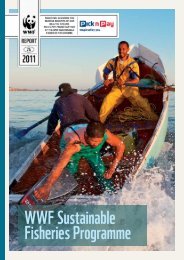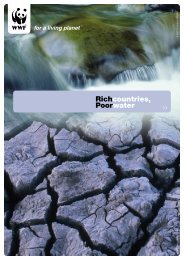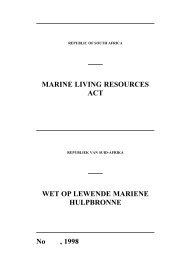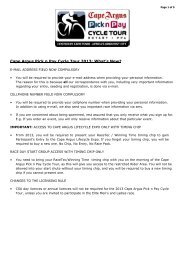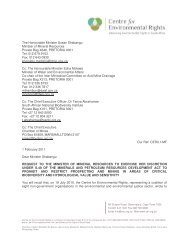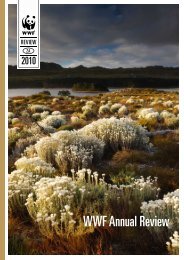State of Management of South Africaââ¬â¢s ... - WWF South Africa
State of Management of South Africaââ¬â¢s ... - WWF South Africa
State of Management of South Africaââ¬â¢s ... - WWF South Africa
- No tags were found...
You also want an ePaper? Increase the reach of your titles
YUMPU automatically turns print PDFs into web optimized ePapers that Google loves.
STATE OF MANAGEMENT OF SOUTH AFRICA’S MARINE PROTECTED AREASBhanga Nek, Sodwana, Cape Vidal, St Lucia and Mapelane. Each station has a designatedconservation manager and field staff. The Bhanga Nek, Sodwana and Cape Vidal stationswere located within the MPAs. There were six field rangers at Bhanga Nek, eight at Sodwanaand six at Cape Vidal.The total number <strong>of</strong> staff was viewed as adequate for most critical management activities atBhanga Nek and Cape Vidal, however it was noted that the Sodwana node was in need <strong>of</strong> afurther four field rangers due to the high activity level within the MPA.<strong>South</strong>ern excluded sectionThere are seven staff members under the conservation manager at Mapelane and 15 underthe conservation manager at St Lucia.STAFF SKILLS (91%)It was indicated that the staff had satisfactory skills and training to conduct present and likelyfuture duties. The field rangers received in-house training regarding the role and function <strong>of</strong>the MPAs, its resources and the applicable legislation from the conservation managers attheir stations. There were qualified skippers at two <strong>of</strong> the stations within the MPA and amember from the Bhanga Nek station was undergoing skippers training. All <strong>of</strong> the staff aredesignated FCOs but were awaiting the issue <strong>of</strong> their FCO cards. All were Peace Officers,competent swimmers and could use a GPS. The following training needs were identified: SCUBA divers Additional skippers EMI training for the conservation managers Radio operators tickets<strong>South</strong>ern excluded sectionThe staff members have sufficient skills and training to conduct present and likely futureduties. There were skippers at both stations and a diver at St Lucia.EQUIPMENT (78%)The availability <strong>of</strong> equipment did not constrain critical management operations. Maintenance<strong>of</strong> equipment was taking place in accordance with the relevant maintenance schedules to asatisfactory standard. There was an on site workshop for basic maintenance <strong>of</strong> vehicles.All three stations within the MPA had sufficient sea-going boats (however, use was limited atBhanga Nek due to current lack <strong>of</strong> skipper), vehicles, radios and basic enforcementequipment for field rangers. Identified needs included: Night vision equipment for night operations Binoculars Spotting scope Snorkelling and diving equipment to assist in monitoringPg 135






